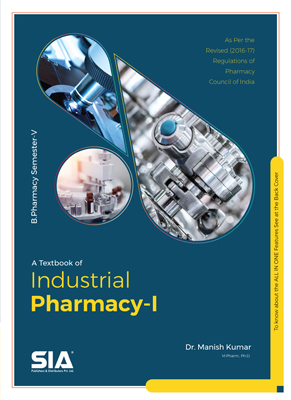

Note: Please check your Spam or Junk folder, in case you didn't receive the email with verification code.
SYLLABUS
Unit-I
Preformulation Studies: Introduction to preformulation, goals and objectives, study of physico-chemical characteristics of drug substances. (a) Physical Properties: Physical form (crystal & amorphous), particle size, shape, flow properties, solubility profile (pKa, pH, partition coefficient), polymorphism. (b) Chemical Properties: Hydrolysis, oxidation, reduction, racemization, polymerization BCS classification of drugs & its significance. Application of preformulation considerations in the development of solid, liquid oral and parenteral dosage forms and its impact on stability of dosage forms.
Unit-II
Tablets (a) Introduction, ideal characteristics of tablets, classification of tablets. Excipients, formulation of tablets, granulation methods, compression and processing problems. Equipments and tablet tooling. (b) Tablet Coating: Types of coating, coating materials, formulation of coating composition, methods of coating, equipments employed and defects in coating. (c) Quality Control Tests: In process and finished product tests. Liquid orals Formulation and manufacturing consideration of syrups and elixirs, suspensions and emulsions; filling and packaging; evaluation of liquid orals official in pharmacopoeia.
Unit-III
Capsules (a) Hard Gelatin Capsules: Introduction, production of hard gelatin capsule shells. Size of capsules, filling, finishing and special techniques of formulation of hard gelatin capsules, manufacturing defects. In process and final product quality control tests for capsules. (b) Soft Gelatin Capsules: Nature of shell and capsule content, size of capsules,importance of base adsorption and minim/gram factors, production, in process and final product quality control tests. Packing, storage and stability testing of soft gelatin capsules and their applications. Pellets Introduction, formulation requirements, pelletization process and equipments for manufacture of pellets.
Unit-IV
Parenteral Products (a) Definition, types, advantages and limitations. Preformulation factors and essential requirements, vehicles, additives and importance of isotonicity. (b) Production procedure, production facilities and controls, aseptic processing. (c) Formulation of injections, sterile powders, large volume parenterals and lyophilized products. (d) Containers and closures selection, filling and sealing of ampoules, vials and infusion fluids. Quality control tests of parenteral products. Ophthalmic Preparations Introduction, formulation considerations; formulation of eye drops, eye ointments and eye lotions; methods of preparation; labelling, containers and Evaluation of ophthalmic preparations.
Unit-V
Cosmetics Formulation and preparation of the following cosmetic preparations: lipsticks, shampoos, cold creams and vanishing creams, tooth pastes, hair dyes and sunscreens. Pharmaceutical Aerosols Definition, propellants, containers, valves, types of aerosol systems; Formulation and manufacture of aerosols, Evaluation of aerosols; Quality control and stability studies. Packaging Materials Science Materials used for packaging of pharmaceutical products, factors influencing choice of containers, legal and official requirements for containers, stability aspects of packaging materials and quality control tests.
 No Preview is available for this book
No Preview is available for this book

 Get 100 instant uPoints on the purchase of Rs.100 or above for each order.
Get 100 instant uPoints on the purchase of Rs.100 or above for each order.
CategoriesPharmacy

Format PDF

TypeeBook